How to Grow an Avocado Plant: From Seed to Sprout
- February 7, 2024
- 5 comment
Avocado plants, with their lush green foliage and creamy, nutritious fruit, are not only a delicious addition to your diet but also make for attractive indoor or outdoor plants. Growing an avocado plant from seed can be a rewarding and educational experience. In this guide, we’ll take you through the step-by-step process of cultivating your own avocado plant at home.
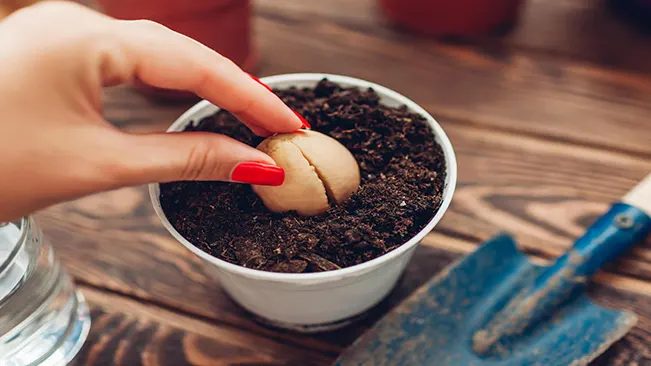
Benefits of Planting Avocados
| Benefits | Description |
|---|---|
| 1. Nutrient-Rich Fruit | Avocados are packed with essential nutrients, including healthy fats, vitamins (such as B vitamins, vitamin K, and vitamin E), and minerals (like potassium). Consuming avocados contributes to a well-balanced diet. |
| 2. Ornamental Value | Avocado plants, with their lush green foliage, make attractive additions to both indoor and outdoor spaces. They can enhance the aesthetics of your garden or home decor. |
| 3. Oxygen Production | Like all plants, avocados engage in photosynthesis, releasing oxygen as a byproduct. Having avocado plants contributes to increased oxygen levels in your environment. |
| 4. Sustainable Food Source | Growing your own avocados at home can contribute to a sustainable and local food source. It reduces the need for transportation and packaging associated with store-bought avocados. |
| 5. Educational Experience | Planting and caring for an avocado seed provides a hands-on and educational experience, especially for children. It offers insights into plant growth, biology, and the importance of sustainable practices. |
| 6. Potential for Home-Grown Avocados | While not guaranteed, successfully grown avocado plants have the potential to produce fruit, offering a supply of home-grown avocados with unique flavors and varieties. |
| 7. Air Purification | Indoor avocado plants contribute to air purification by absorbing pollutants and volatile organic compounds, enhancing the overall air quality in your home. |
| 8. Soil Health Improvement | Avocado plants, when grown outdoors, can contribute to soil health by preventing erosion, promoting microbial activity, and enhancing nutrient cycling. |
| 9. Stress Reduction | Gardening, including caring for avocado plants, has been linked to stress reduction and improved mental well-being. The process of nurturing a plant can be therapeutic. |
| 10. Biodiversity Support | Avocado plants attract pollinators such as bees, which supports biodiversity in your garden. This can have positive effects on the health of other plants in the vicinity. |
Different Varieties of Avocado
Hass Avocado
Description: The most widely known and consumed avocado variety.
Characteristics: Rough, pebbly skin that turns from green to purplish-black when ripe. Creamy texture and nutty flavor.
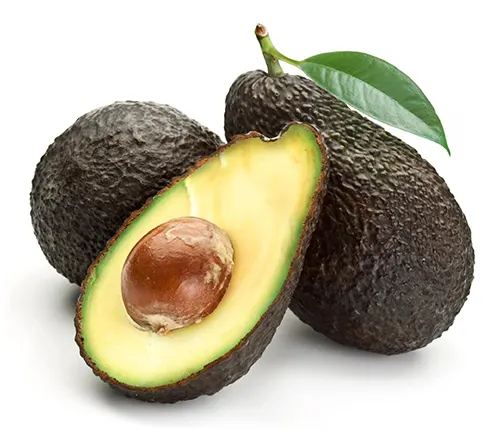
Fuerte Avocado
Description: Often called the “green-skin” avocado.
Characteristics: Smooth, thin skin that remains green even when ripe. Creamy texture and a slightly milder taste compared to Hass.
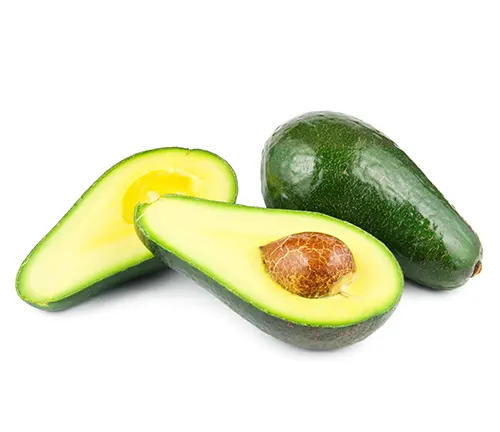
Pinkerton Avocado
Description: Known for its long, pear-like shape.
Characteristics: Smooth, green skin. Creamy texture similar to Hass with a slightly lighter flavor.

Zutano Avocado
Description: Distinctive for its pear-shaped appearance.
Characteristics: Light-green, smooth skin. Flesh is firmer and less creamy compared to other varieties.

Bacon Avocado
Description: Named after its original cultivator, James Bacon.
Characteristics: Medium-sized, with smooth, thin skin. Creamy texture and a lighter, more subtle flavor.

Gwen Avocado
Description: A hybrid between Hass and Gwen varieties.
Characteristics: Small to medium-sized fruit with green, pebbly skin. Creamy texture and a nutty, buttery taste.
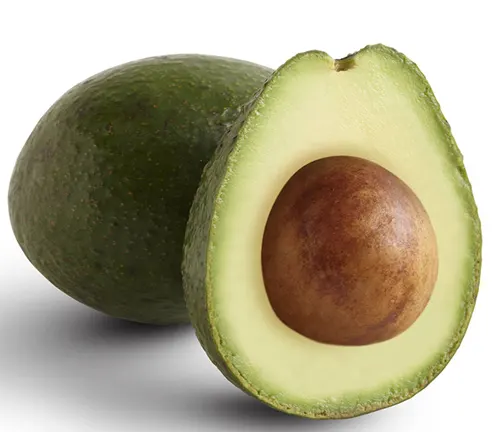
Reed Avocado
Description: Known for its large size and round shape.
Characteristics: Thick, pebbly skin that remains green even when ripe. Creamy, buttery texture and a rich flavor.
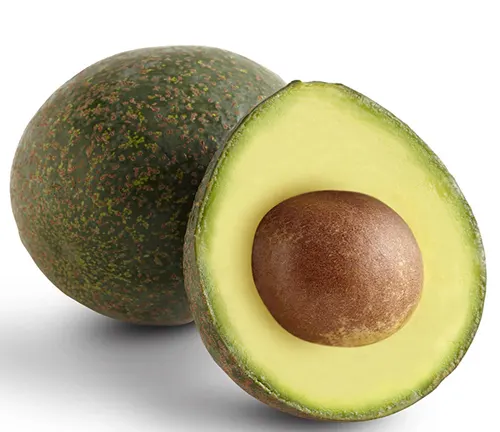
Lula Avocado
Description: Developed in Florida, primarily for warm climates.
Characteristics: Medium-sized fruit with smooth, green skin. Creamy texture and a mild, nutty taste.

Ettinger Avocado
Description: Originally from Israel.
Characteristics: Long, slender fruit with a smooth, green skin. Creamy texture and a mild flavor.
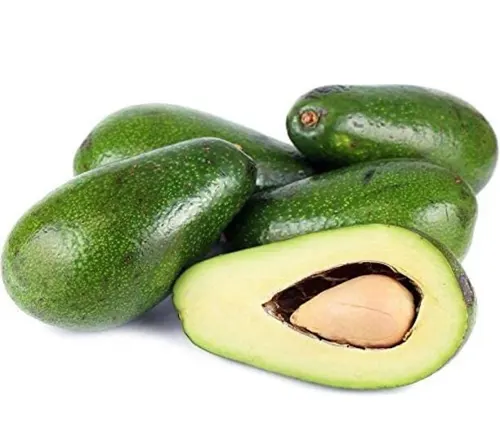
Cocktail Avocado (Mini or Baby Avocado)
Description: Smaller than regular avocados, often about the size of a lime.
Characteristics: Typically has a thinner skin, and the taste is similar to larger avocados.
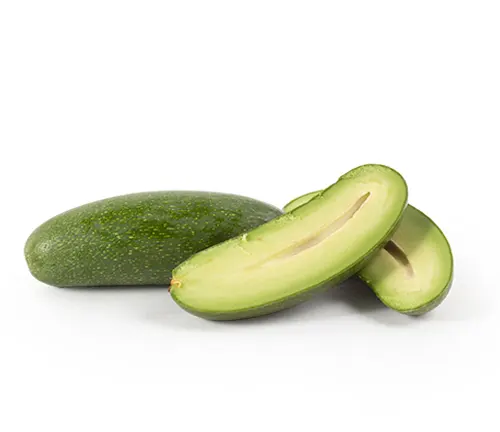
Choose a Ripe Avocado
Start by selecting a ripe avocado. Choose one that is not too firm but not overly mushy. Cut the avocado in half, and remove the seed carefully.
Select a Mature Avocado
Opt for a fully mature avocado. It should have a dark, even color, and the skin should be free of green patches. Different varieties of avocados have different skin colors when ripe, so familiarize yourself with the specific variety you are working with.
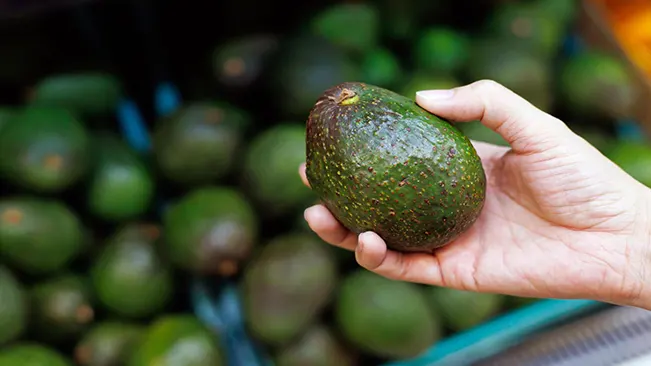
Check for Firmness
Gently squeeze the avocado to assess its firmness. A ripe avocado should yield slightly to gentle pressure without feeling mushy. Avoid overly soft avocados, as they may be overripe and not suitable for planting.

Inspect the Stem End
Look at the small, woody stem at the top of the avocado. Gently flick it open. If it comes off easily and reveals green flesh underneath, the avocado is likely ripe. If it is difficult to remove or if the flesh underneath is brown, the avocado may be overripe or underripe.
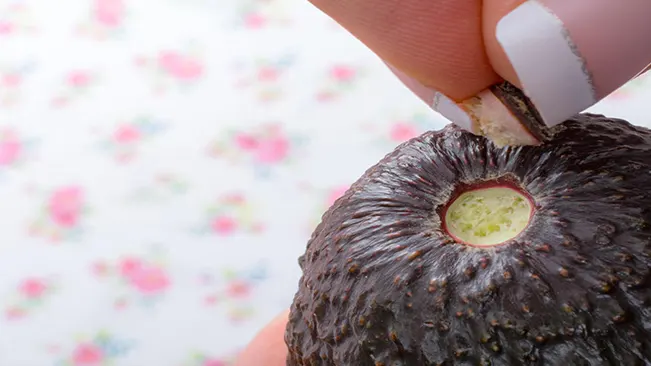
Consider the Skin Texture
The skin of a ripe avocado should be slightly bumpy or pebbled. However, this characteristic can vary between avocado varieties. Avoid avocados with smooth or shiny skin, as they may not be fully mature.
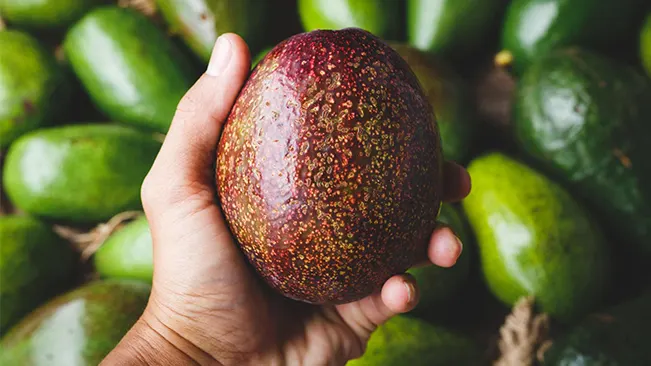
Smell the Avocado
A ripe avocado typically has a mild, sweet aroma. If the avocado has a strong, unpleasant odor, it may be overripe or starting to spoil.
Size and Shape
Choose avocados that are well-rounded and have a consistent shape. Irregularities or indentations may indicate bruising or uneven ripening.
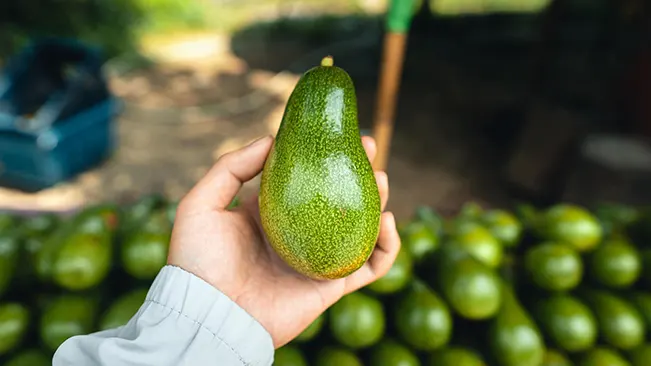
- Consider the Purpose
If your primary goal is to grow an avocado plant, you don’t necessarily need a perfect, flawless avocado for consumption. Focus on the seed inside, which should be undamaged and healthy. - Buy Multiple Avocados
To increase the chances of finding a suitable avocado for planting, consider purchasing several avocados at once. This allows you to select the best one for germination.
Clean and Prepare the Seed
Gently wash the avocado seed to remove any remaining fruit. Be cautious not to damage the brown skin covering the seed. Allow the seed to air-dry for a day.
Cutting and Extracting the Seed
Start by cutting a ripe avocado in half. Gently remove the seed from the fruit, taking care not to damage the brown skin (seed coat) covering the seed.
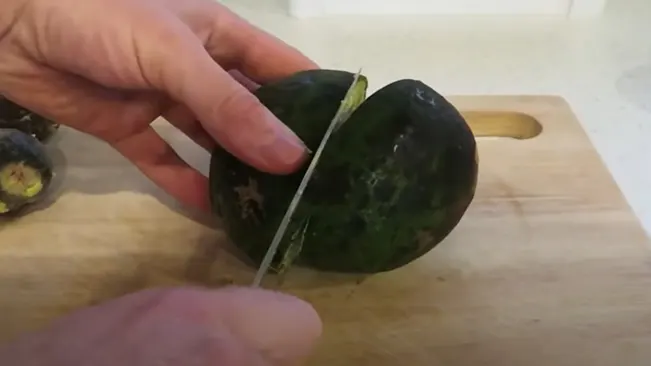
Removing Residual Fruit
After extracting the seed, it’s essential to clean off any remaining avocado fruit attached to the seed. Use your fingers or a soft brush to gently remove the fruit pulp without damaging the seed coat.
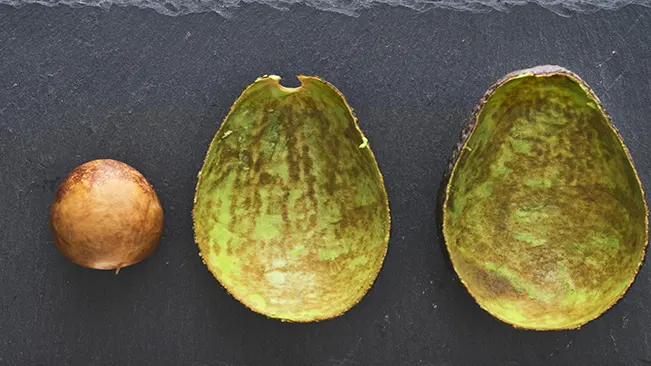
Rinsing the Seed
Rinse the avocado seed under cool, running water to wash away any remaining fruit residue. Be gentle to avoid damaging the seed coat, as it protects the embryo inside.

- Air Drying: Place the cleaned avocado seed on a paper towel or dishcloth to air dry. Allow it to dry for at least 24 hours. The drying process helps prevent the seed from rotting during the germination phase.
Inspecting for Damage
Take a moment to inspect the seed for any signs of damage or mold. If you notice any soft spots, cracks, or discoloration, it’s advisable to choose another seed, as damaged seeds are less likely to germinate successfully.

Optional: Removing the Seed Coat (Hulling)
While not necessary, some people choose to remove the outer seed coat, or hull, to potentially speed up germination. Gently peel away the brown skin, being careful not to damage the inner seed.
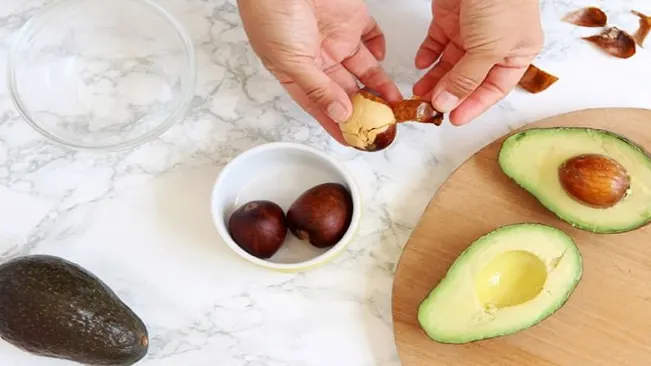
Insert Toothpicks and Suspend the Seed
Pierce the avocado seed with three to four toothpicks at equal intervals, ensuring they are evenly spaced around the circumference. Suspend the seed, pointy side up, over a glass or jar filled with water. The toothpicks should support the seed, allowing the bottom to immerse in the water.
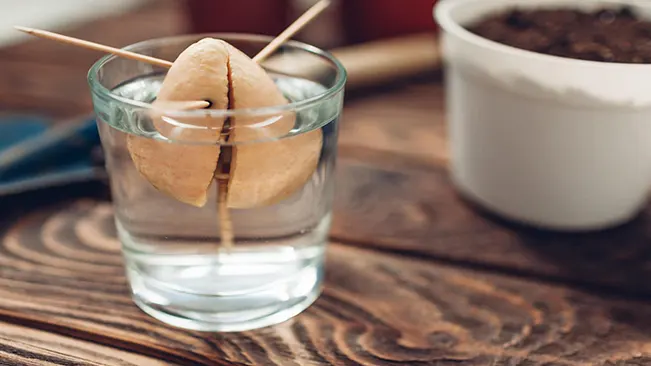
Take three to four toothpicks and insert them into the avocado seed at equal intervals around its circumference. Position the toothpicks in a way that allows you to suspend the seed over a glass or jar with the pointed end facing up.
Suspend the Seed
Using the toothpicks as support, suspend the avocado seed over a glass or jar filled with water. The toothpicks should allow the bottom half of the seed to be immersed in the water while keeping the top half exposed.

Place in a Sunny Spot
Position the suspended avocado seed in a warm, sunny location. A window sill with indirect sunlight is ideal. The seed will gradually develop roots from the bottom and a stem from the top.

Change Water Regularly
Change the water in the glass or jar regularly, at least every few days. This helps prevent the growth of mold and provides a clean environment for the developing roots.
Wait for Roots and Sprout
Over 2-6 weeks, you should observe the emergence of roots from the bottom of the seed and a stem from the top. Once the roots are around 2-3 inches long and the stem has reached a similar height, the avocado seed is ready to be transplanted into the soil.
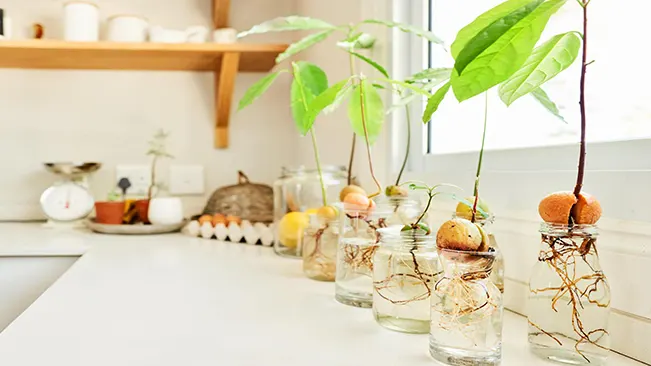
Pruning and Maintenance
As your avocado plant grows, you may need to prune it to encourage bushier growth. Pinch off the top leaves to encourage branching. Additionally, rotate the pot occasionally to ensure even growth.
Pruning Basics
- Timing: Prune your avocado plant during the late winter or early spring, just before the growing season begins. This allows the plant to recover and put energy into new growth.
- Tools: Use sharp, clean pruning shears or loppers to make clean cuts and minimize the risk of disease transmission.
- Objective: The primary goals of pruning avocado plants are to maintain a desirable shape, remove dead or diseased branches, and encourage bushier growth.
Remove Dead or Diseased Wood
Identify and remove any dead or diseased branches promptly. This helps prevent the spread of diseases and ensures that the plant directs energy toward healthy growth.
Encourage Bushier Growth
Pinch off the tips of young branches to encourage lateral branching and a fuller, bushier plant. This will also help control the height and shape of the avocado tree.
Control Height
Avocado trees can grow quite tall, making it challenging to manage them indoors or in limited spaces. Prune the top of the plant to control its height and encourage lateral growth.
Thinning Out Excess Growth
Remove crowded or excess branches to allow better air circulation and light penetration. This helps prevent diseases and ensures that all parts of the plant receive adequate sunlight.
Limiting Size for Indoor Growth
If you’re growing avocados indoors, regular pruning is essential to control the size of the plant. Trim back long branches to maintain a manageable size for indoor spaces.
Post-Transplant Pruning
After transplanting your avocado plant into a larger pot, consider pruning back a portion of the top growth to balance the root-to-shoot ratio and reduce stress on the plant.
Fertilization
Provide a balanced fertilizer during the growing season to support healthy foliage and potential fruiting. Follow the recommended dosage on the fertilizer packaging.
Watering
Maintain a consistent watering schedule, allowing the top inch of soil to dry out between waterings. Avoid overwatering, as this can lead to root rot.
Pest Management
Regularly inspect your avocado plant for pests. If you notice any infestations, take appropriate measures, such as using insecticidal soap or neem oil, to protect the plant.
Harvesting
The timing for harvesting avocados can vary depending on the avocado variety and growing conditions. Regularly monitor your avocado trees and test a few fruits for ripeness before harvesting the entire crop.
- Determine Maturity
Avocados do not ripen on the tree, so it’s crucial to determine when they are mature. The best indicator is the color of the fruit, as well as its size and firmness. - Check the Skin Color
For most varieties, the skin color changes as the fruit matures. For example, Hass avocados change from green to a dark purplish-black. Other varieties may shift from green to a lighter shade. - Assess Size and Firmness
Gently squeeze the avocado to assess its firmness. A mature avocado should yield slightly to pressure but not feel overly soft. Size is also an indicator; the fruit should be a suitable size for its variety. - Test Removal Readiness
Pick one or two avocados to test their removal readiness. If they separate easily from the tree with a slight twist, it’s a sign that the fruit is ready to harvest. - Use Pruning Shears or Loppers
Use pruning shears or loppers to cut the stem, leaving a short portion attached to the fruit. Be careful not to damage the fruit during the harvesting process. - Harvest Time
Avocado harvest times can vary depending on the specific variety and climate. In general, avocados are typically ready for harvest from late spring through fall. - Harvesting by Hand
For hand harvesting, carefully reach for the avocados, making sure not to drop or bruise them. Hold the fruit gently and twist it off the stem. - Use a Picking Pole (Optional)
In commercial orchards or for tall trees, a picking pole with a basket attachment may be used to reach higher branches. This helps avoid the need for climbing ladders. - Collect in Baskets or Buckets
Place harvested avocados in baskets or buckets, taking care not to overload or stack them too high to prevent bruising. - Sorting and Packing
After harvesting, sort avocados based on size and quality. Pack them carefully in containers for transport to markets or storage. Handle them gently to minimize bruising. - Allow for Ripening
Once harvested, avocados may need some time to ripen fully. Place them in a paper bag with a banana or apple to speed up the ripening process. - Store Properly
Store harvested avocados in a cool, dark place until ready to use. Refrigerate if necessary, but avoid excessively low temperatures, as they can affect the fruit’s quality.
Conclusion
Growing an avocado plant from seed can be a fun and fulfilling experience. With patience and proper care, you can watch your avocado seed transform into a thriving plant. Whether you choose to keep it as a houseplant or eventually transplant it outdoors, your homegrown avocado plant will be a source of pride and perhaps even provide delicious avocados in the future. Happy growing!
FAQs (Frequently Asked Questions)
- Can I grow an avocado plant from store-bought avocados?
Yes, you can. Choose a ripe avocado, extract the seed, and follow the necessary steps for germination. - When is the best time to plant an avocado seed?
Avocado seeds can be planted year-round, but spring is often considered the best time as it provides a warm and conducive environment for germination. - Do I need a special type of soil for planting avocados?
Avocados prefer well-draining soil. Use a quality potting mix suitable for container gardening with good aeration and drainage. - How deep should I plant the avocado seed in the soil?
Plant the avocado seed with the top half exposed above the soil surface. Ensure the soil covers the bottom half of the seed. - How much sunlight does an avocado plant need?
Avocado plants thrive in full sunlight. Provide at least 6-8 hours of direct sunlight daily for optimal growth. - Can I grow avocados indoors?
Yes, avocados can be grown indoors. Place the plant near a sunny window or use artificial grow lights to supplement sunlight. - How often should I water my avocado plant?
Allow the top inch of soil to dry out before watering. Overwatering can lead to root rot, so it’s important to maintain a balanced watering schedule. - How long does it take for an avocado seed to sprout?
Avocado seeds typically take 2-6 weeks to sprout roots and a stem when suspended in water. However, this can vary. - When should I transplant my avocado plant into a larger pot?
Transplant the avocado plant into a larger pot when its roots outgrow the current container. This is usually done every 1-2 years. - Will my avocado plant produce fruit?
While it’s possible for a homegrown avocado plant to produce fruit, it often takes several years, and there’s no guarantee. Most avocado trees grown from seeds may not bear fruit identical to the parent plant. For consistent fruit production, consider grafting or purchasing a grafted avocado tree.

Kristine Moore
Forestry AuthorI'm Kristine Moore, a seasoned garden landscaping professional with over 30 years of experience. My extensive career has been dedicated to transforming outdoor spaces into stunning, sustainable landscapes. With a deep understanding of horticulture, design principles, and environmental stewardship, I have become a respected figure in the field, known for creating harmonious, visually appealing, and eco-friendly gardens. My commitment to excellence and continuous learning in landscaping trends and techniques has solidified my reputation as an expert in garden design and implementation.
5 comments
Thanks for the education. Is there any way you can support me in case I want to grow on a large scale. And how can I identify the best quality.
KATANKU SOLOMON
February 14, 2024 5:00 amVery interested
Rodolfo Farguharson
February 14, 2024 12:53 amI'm very interested I will do something like this!
Rodolfo Farguharson
February 14, 2024 12:52 amLike your idea thanks

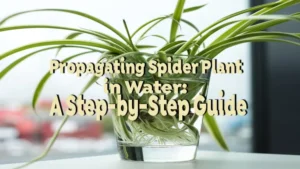


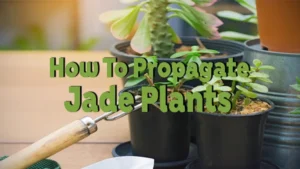




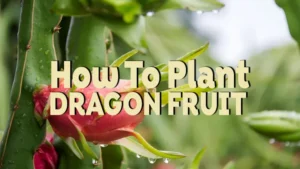



Interested in JV avocado farming in Tanzania or outright purchase of existing farm? You are welcomed
George Lupembe
February 14, 2024 12:11 pm